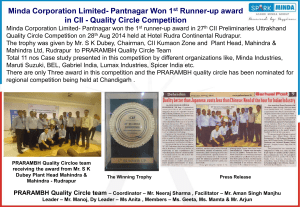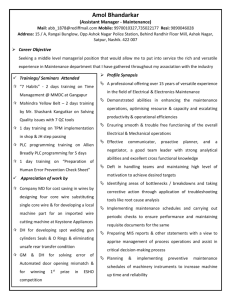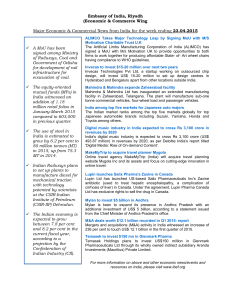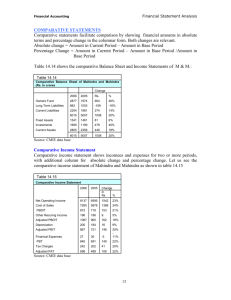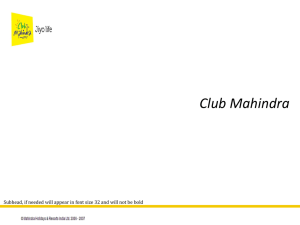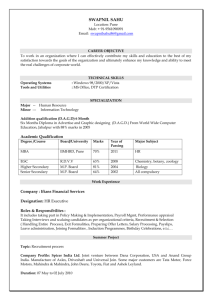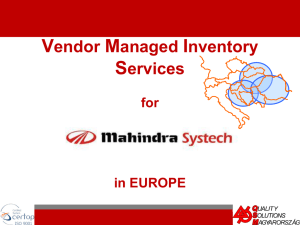COP
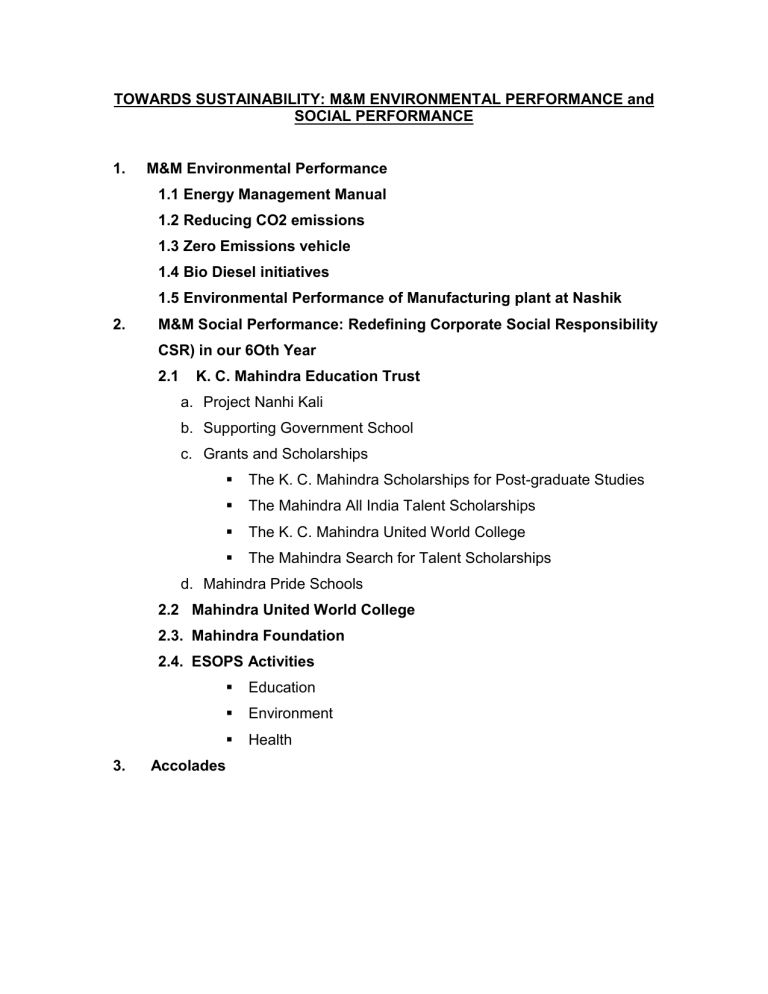
TOWARDS SUSTAINABILITY: M&M ENVIRONMENTAL PERFORMANCE and
SOCIAL PERFORMANCE
1. M&M Environmental Performance
1.1 Energy Management Manual
1.2 Reducing CO2 emissions
1.3 Zero Emissions vehicle
1.4 Bio Diesel initiatives
1.5 Environmental Performance of Manufacturing plant at Nashik
2. M&M Social Performance: Redefining Corporate Social Responsibility
CSR) in our 6Oth Year
2.1 K. C. Mahindra Education Trust a. Project Nanhi Kali b. Supporting Government School c. Grants and Scholarships
The K. C. Mahindra Scholarships for Post-graduate Studies
The Mahindra All India Talent Scholarships
The K. C. Mahindra United World College
The Mahindra Search for Talent Scholarships d. Mahindra Pride Schools
2.2 Mahindra United World College
2.3. Mahindra Foundation
2.4. ESOPS Activities
Education
Environment
Health
3. Accolades
1. M&M ENVIRONMENTAL PERFORMANCE
1.1: Energy Management Manual / Energy Policy
A foresighted concern for Global Warming and Climate Change has driven the company to formulate a comprehensive Energy Management Manual / Energy
Policy in 2006. This manual forms the seed of a company wide action plan to recognize opportunities and strategies in energy conservation / renewable energy that can take the Mahindra Group to the next level of sustainable energy use in process and product design.
1.2: Reducing CO2 emissions :
Aiming to contribute towards mitigation of Climate Change the Mahindra group has identified three projects in the Auto Sector and Farm Equipment Sector which will measure the CO2 emissions from these manufacturing plants with an aim to reduce the emissions every year. This effort will serve as a learning experience which can then be extended to all manufacturing operations and lead to a companywide emission control and reduction program.
1.3: Zero Emissions Vehicle
The Bijlee
The Bijlee is an innovative, home grown, first-of-its-kind electric three wheeler,
India’s tried and tested battery operated vehicle.
The Bijlee is an innovative “Kind to Man” technology initiative from Mahindra &
Mahindra’s alternate fuel programme . It is a zero emission electrically powered vehicle that runs on a 72 volts DC motor. The Bijlee’s 12 batteries allow the customer to do 80 km at a speed of 35 km/hour. With a replacement battery on board the vehicle can easily give 120 kms. The electric vehicle has spacious interiors, with ample space for an entire family. It has no engine, gearbox radiator and no silencer, which makes it a virtually noise free vehicle. Bijlee gives quality output without choking the environment and is favoured by governments and institutions, which lay focus on conserving the environment. 10 Mahindra Bijlees were handed over to customers in 2006 by the Chief Minister of Puducherry
(formerly known as Pondicherry) as part of the Puducherry government’s drive to promote environment friendly vehicles and conserve the Union territory’s pristine heritage.
1.4: Bio-Diesel Initiatives
Apart from the Zero
Emissions Vehicle, Bijlee,
Mahindra has also developed the bio-diesel
Scorpio and Bolero DI vehicles for 100% real world usage trials. The
Scorpio with indigenously developed CRDE technology is the first Asian vehicle in its class to run on
100% bio-diesel. .
M&M has also shown its commitment to sustainable energy goals by developing a 5% bio-diesel tractor along with the utility vehicles, another first in the country.
Mahindra has always nurtured a technology-driven commitment to fuel conservation. The Group has an over 700-strong R&D team with the proven in-house capability to develop contemporary bio-diesel engines
& emissions reduction capability.
The bio-diesel vehicles are a result of M&M’s pioneering research and unmatched expertise in India’s alternate fuel and engine development domains.
1.5. ENVIRONMENTAL PERFORMANCE AT THE AUTO MANUFACTURING
PLANT IN NASHIK, MAHARASHTRA.
Location: Mahindra & Mahindra Ltd, Automotive Sector, Plot no. 80,89. M.I.D.C.,
Satpur, Nashik, Maharashtra, PIN: 422007.
Industry Sector : Engineering
Product Range/ scope : Design, Development and Manufacturing of multi-utility vehicles, sports utility vehicles and related aggregates, components and tooling items like press tools, dies, moulds, fixtures, jigs and other related services.
Stake holders in EMS of the unit : Employees, neighbouring factories, neighbouring residents, Govt authorities like State Pollution Control Board,
General Public, MIDC, Nashik Municipal Corporation, media, Third party certification etc.
Concerns of stake holders : There are no any adverse concerns. Moreover, local newspapers and local TV channels have specially published/telecast the news reports of our efforts for greening Nashik school premises. Also they have reported (in positive light) about our annual Environmental publicat ion, “Srushti”.
Organisation Specific Indicators: a) Economic issues: i. Electrical energy consumption ii. Water consumption iii. Hazardous waste disposal iv. Cost of packaging b) Environmental issues: i. Air pollution: Global warming ii. Water pollution iii. Noise pollution iv. Land contamination v. Use of CFC: Ozone depletion vi. Consumption of natural resources c) Social Issues: i. ii.
Feed back from neighbouring factories
Feed back from neighbouring residents
Operations of Nashik Plant : i. Manufacturing: Press shop, Vehicle Body fabrication, Pre-treatment, priming, painting of body shells, assembly of MUV and SUV, and associated support services like supply chain management, utilities, vehicle despatch, etc. ii. R&D: Design, Development of multi-utility vehicles, sports utility vehicles and related aggregates, components iii. Die shop (Plant 2): Manufacturing of tooling items like press tools, dies, moulds, fixtures, jigs and other related services.
Products : Multi Utility vehicles like Bolero, Invader; Sports Utility vehicles like
Scorpio and their variants.
A) Legal Compliance : The AS Nashik unit has prepared a legal applicability register for the applicable environmental legislation and the related monitoring matrix. Legal compliance is ensured through timely actions in the areas of: a. Procedural requirements b. On site compliance c. Measurement & monitoring
Legal compliance evaluation audit is conducted at least once a year using professional EHS-(Environment, Health and Safety) legal experts and findings are acted upon promptly. The plant has an excellent record for its legal compliance and the third party certification agency, namely M/s TUV India Ltd, has lauded the organisation’s efforts in this area.
1. Training imparted to all EMS (Environmental Management System) Dept MRs
(Management Representatives) and HSE (Health, safety and environment) champions on applicable legal requirements.
2. Plant level and dept level Legal compliance check lists prepared.
3. Legal compliance evaluation carried out annually using experts.
4. Legal register and monitoring matrix prepared and is updated.
5. Measurement and monitoring of pollutants carried out six monthly using external MOEF (Ministry of Environment & Safety) approved laboratory.
6. Reports from DISH (Directorate of Industrial Safety & Health), MPCB
(Maharashtra Pollution Control Board), CCOE (Chief Controller of Explosives) acted upon promptly.
7. Special need based focused audits conducted using experts in areas like LPG,
Paint shops.
8. Statutory testing of lifting material handling equipment carried out every six months using competent persons.
M&M has not paid any penalties for any non conformance of legal requirements.
B) ISO 14001: 2004 Certification:
Mahindra & Mahindra Ltd. Automotive Sector, Nashik site which includes its vehicle Manufacturing operation, R&D, Plant 2 Die shop and tool room activities; has been certified for its Environmental Management System using ISO
14001:1996 version since March 2004. We upgraded its system to 2004 version since March 2006.
C) Environmental Initiatives:
The environmental Performance enhancement is achieved through setting and reviewing EMS Objectives and Targets, management programmes at plant level and at relevant functional levels. These are in line with the Environmental Policy approved by the sector president.
Some of the key Environmental initiatives and areas of achievement in Nashik site are as follows.
1. Air Pollution:
1. Exhaust provided for all stacks in paint shops.
2. Incinerators for ensuring complete combustion of flue gases
3. Scrubber for removing Suspended Particulate Matter
4. Pollution levels monitored every six months using external professional Lab.
- Ambient Air, Ambient noise
- Combustion Stacks
- Process Stacks
- Work Place Air, noise
5. Use of Ear Muffs, Ear plugs ensured in all high noise areas
2. Water Pollution :
1. State of the Art combined STP (Sewage Treatment Plant) and ETP (Effluent
Treatment Plant) installed in Plant 1; STP in Plant no. 2- Die shop. Plant 1
STP/ETP has been shifted with up-gradation in capacity.
2. Operation and Maintenance of ETP/STP closely monitored.
3. Effluent pollution parameters monitored
- every day through internal lab
- every week with external lab
- every month through MPCB Lab.
- Treated effluent is reused for gardening and urinal flushing.
4. Oil Water Separation Plant installed in R&D for
Separating oil from oil mixed water generated in Engine Test lab.
Parameters monitored monthly.
5. Sewage treatment plant along with the machine Coolant treatment facility in
Plant
II. Parameters monitored monthly with ext. Lab.
3. Soil Pollution:
1. All types of sludge arising out of Paint shops, ETP, Oil contaminated
cotton waste is disposed through MPCB authorised Central Hazardous
Waste Treatment and Disposal Site (CHWTDS). Currently it is MWML
(Mumbai
Waste Management Ltd).
2. Waste oils, battery waste is disposed through MOEF authorised recyclers.
3. Other hazardous waste is disposed through MPCB authorised parties.
4. Packaging waste is recycled.
5. Non hazardous waste is sold for onward recycling/reuse.
4. Noise Pollution:
1. Acoustic enclosures provided to 7 Nos. D.G. sets (Diesel Generator) getting
25 dB(A) ( decibel level on A scale) insertion Loss and meeting MPCB noise norms.
2. Acoustic Treatment Provided to Engine test cabins
3. Use of ear muffs and ear plugs ensured in all high noise areas
4. PPE usage audits conducted in all related areas.
5. Audiometry test conducted annually for all employees working in high noise
areas.
6. Contract documents clarifying responsibility of contractors to ensure use of ear
muffs by their laborers
5. Waste Minimisation:
1. Objectives and targets set for each dept for waste minimisation.
2. Management programmes (MPs) taken by each dept in this area.
3. Progress reviewed periodically and in each dept MRM (Management Review
Meeting).
4. Importance emphasized in each training programme.
Major achievements:
- Sludge reduction in ETP, paint shops
- Reduction in generation of oil contaminated cotton waste
- Reduction in packaging waste.
6. Efforts for conservation of natural resources and Energy:
1. Energy Conservation Team formed from Cross functional representation under
Chairmanship of DGM- Central Maintenance
2. Kaizens implemented for energy saving.
3. Energy conservation audits conducted and recommendations implemented
4. Thermal efficiency audit conducted.
5. Objectives, targets and management programmes taken up by each dept
consuming fuels, oils, solvents, chemicals etc.
6. Specific consumption of energy and critical natural resources monitored closely.
7. Performance on water and electricity conservation monitored through reviews.
7. Emergency Preparedness:
1. All potential emergency situations identified through aspect-impact study.
2. Preventive actions taken by respective depts. to ensure emergencies do not arise.
3. Plant level Onsite Emergency Preparedness and Response Plan prepared and
updated regularly.
4. Training on OEP (Onsite Emergency Preparedness Plan) given to employees through mock drills and training sessions.
5. Six monthly mock drills conducted in critical areas like Paint shops and LPG area.
6. Fire fighting equipment is maintained by Fire Officer.
7. Fire Training conducted by Fire Officer.
8. Involvement of stake holders in Environment Protection:
1. Environment Policy shared with all employees, contractors & the public.
2. Competitions are held for HSE areas involving employees, their spouses and
children.
3. Training sessions conducted for contractors and vendor personnel.
4. “Srushti” an annual EHS Publication started.
Copies distributed to all employees and stake holders.
5. Close liaison with Govt authorities like MPCB, DISH.
6. Suggestions from employees, neighbors on environment protection acted upon
promptly and feed back is given.
7. 2000 Trees planted in 19 schools premises involving Govt dignitaries during
June
2005 to Oct 2007.
(Tree planting at Nashik on 17 th June ’07, involving the local community)
9. EMS Integration in Product Design: i. Environmental legislation regarding product design, especially the ii. norms for air pollution, noise pollution are integrated in product design through well designed Mahindra product development system.
Management programmes are undertaken for improving fuel consumption, noise reduction, weight reduction, use of environment friendly materials, developing alternative fuels, etc. iii. As far as CMVR & Homologation Department is concerned, we would like to confirm the following :
All the Products of M & M
– i.e. 4 wheelers, 3 wheelers (passenger vehicles, goods vehicles, pick-ups, commercial vehicles, buses, CNG vehicles, electric vehicles etc.) meet the requirement legislative emission norms and noise norms as applicable.
Presently our vehicles are meeting BS II and BS III emission norms as applicable.
Our vehicles are meeting the stringent noise norms and the emission norms which have become effective from 1.4.2005.
Similarly the vehicles which are being exported to various countries are meeting the emission and noise norms which are applicable to those countries. Also these vehicles are undergoing COP (conformity of production) tests at regular intervals.
For meeting the future emission norms and noise norms – there are action plans in place and they are progressing as per plan.
10. Continual Improvement :
New areas of EMS excellence are continuously explored through internal and external audits, management reviews, use of reference standards like ISO
14004, 14031, 14062, etc. These are put in practice through management programmes.
The company makes exclusive budget provisions for its energy projects. Energy conservation plans, policy and structure are also reviewed periodically. Energy
Conservation weeks are celebrated each year, competition on energy saving are organized and in-house seminars conducted. The importance of energy conservation is emphasised through various forums and TPM (Total Productive
Maintenance) Methodology. The Senior management participates actively in energy conservation and supports the Energy Management Program by providing the necessary support both financially and by boosting the morale through recognition and reward programs.
2: M&M SOCIAL PERFORMANCE
REDEFINING CORPORATE SOCIAL RESPONSIBILITY (CSR) IN OUR 6O TH YEAR
The Mahindra Group has always been conscious of its Corporate Social
Responsibility. The Group-wide belief is that CSR encompasses making socially responsible products, engaging in socially responsible employee relations and making a commitment to the community around us.
1% PAT :In this 60 th Anniversary year, the Mahindra Group planned to give a further thrust to CSR and committed to dedicate 1% of its PAT (Profit After
Tax) towards CSR .
The specific pledges were as follows:
1. Adoption of 6,000 Nanhi Kalis (education opportunities for the girl child, see section 2.1A).
2. Support for 6 Government Schools.
3. Doubling the MAHINDRA ALL INDIA TALENT SCHOLARSHIPS from the present 300 to 600 per year, i.e. an additional 300 scholarships per year.
4. Setting up of 2 Mahindra Pride Schools, for weaker sections of society, particularly for SC / ST.
5. Gifting of 60 Cochlear implants to the hearing challenged.
2.1 : K C MAHINDRA EDUCATION TRUST
The K. C. Mahindra Education Trust was formed by the late Mr. K. C. Mahindra in the year 1953, with an objective to promote education. It is registered as a public Charitable Trust under the Bombay Public Trusts Act, 1950 in April 1954.
Its vision is to ‘transform the lives of people in India through education, by providing financial assistance and recognition to them, across age groups
and across income strata'.
Over the years the K.C. Mahindra Education Trust has undertaken a number of educational initiatives, with the aim make a difference in the lives of deserving students. It has provided more than Rs. 13.8 crores (approximately US $ 3 million) in the form of grants, scholarships and loans. These funds derive from the Trust’s investment portfolio, the main donors of which are the Mahindra
Group of Companies.
2.1 A : PROJECT NANHI KALI
Project Nanhi Kali
– was initiated in 1996 through the K C Mahindra Education
Trust to provide 10 years of quality education to the underprivileged girl child in India .
Nanhi Kali has successfully evolved over the years into a national girl child sponsorship programme, which supports the education of girl children by providing not only academic support but also direct material support in the form of uniforms, clothes, note books etc
In 2005 K. C. Mahindra Education Trust (KCMET) entered into a partnership with
Naandi Foundation, a reputed NGO, to jointly manage the programme.
The project currently (2007) supports the education of over 32,000 underprivileged girl children, a nearly six-fold increase against the previous year. And aims to increase this number of beneficiaries further, extending education to more girl children thereby hoping to mould them into socially responsible citizens.
Nu mb er of
Na nhi
Kal is
30000
25000
20000
15000
10000
5000
0
F-98 F-00 F-02 F-04 F-
07(Mar)
Year
Fig. – No. of Nanhi Kalis being supported by KCMET over the years
Alarmingly the Government of India statistics reveal that only 3 out of ten girls who enter Std 1 actually complete Std 10. Drop out rates are huge and increase in the higher classes. The Nanhi Kali project ’s aim is to ensure every disadvantaged girl child in India is given an opportunity towards a quality education. The trustees believe that It is only through education that she will be able to transform her life, and grow into an independent and self reliant adult.
Modus Operandi of Nanhi Kali :
Needy, underprivileged girls who are at the risk of dropping out of government schools either due to financial constraints or social conservatism, are identified.
Through the programme a special sponsorship is created for them that takes care of a range of their education requirements directly as well as undertaking initiatives to improve the environment and quality of education being provided at the government schools they go to.
Project Nanhi Kali:
Provides direct support to educate the girl child (note books, uniforms, exam fees, learning material etc)
Provides indirect academic support by enriching the learning environment
Sensitizes the parents and community on gender equity
Socio-economic background of the beneficiaries :
Nanhi Kalis typically belong to the lower socio-economic strata of society, their parents earning a measly income as unskilled laborers.
Selecting the girl children
Based on detailed field research, the Nanhi Kali programme has identified certain criteria for selecting the beneficiaries:
Girls who are enrolled in government schools
Girls from poorest sections of society (family income less than Rs 10,000 PA)
Girls who are first generation learners (parents illiterate)
Girls belonging to backward communities (Dalit, tribal & migrant communities)
Eldest girl child and girl children with many siblings
Girl children with the potential to be role models in the community
The Nanhi Kali programme is indeed an excellent example of successful
Corporate – NGO- Civil Society partnership.
This tri
– patriate partnership between the Government of Rajasthan,
Mahindra Group, KCMET, and Naandi Foundation is working together to educate 10,000 tribal girls in Udaipur district.
The Road Ahead:
Nanhi Kali plans to reach out to 100,000 underprivileged girl children by 2008.
2.1 B : SUPPORTING GOVERNMENT SCHOOLS
With an aim to improve the learning level of children in government schools, the
Mahindra Group has entrusted K. C. Mahindra Education Trust to support 6 government schools in the city of Mumbai, which have drop out rates as high as
15% by Std V and 22% by Std VII. A survey conducted in 60 schools in Mumbai revealed that 60% of students studying in Std III would not read even simple paragraphs, 40% in Std IV could not write and 32% were not able to do simple arithmetic. K. C. Mahindra Education Trust has identified Naandi Foundation as our implementation partner to help us support these schools through their
Ensuring Children Learn programme. The schools identified are needy government schools and 5 of them located close to the factories and offices were selected to allow the employees an opportunity to easily volunteer at these field sites.
KCMET and Naandi foundation plans to create learning opportunities for children, by interventions at child level, school level and with the community.
Specifically, this will be done by various means such as by taking children on site visits, organizing fairs, holding reading-writing camps, strengthening libraries, introducing learner-centric methods for teaching etc, academic support classes, timely learning assessment, development of effective and innovative teacher learning material etc.
Special emphasis is placed on the girl children going to school.
Programme implementing partner Naandi’s Ensuring Children Learn strategy, aims to ensure that children coming to BMC (Bombay Municipal Coroporation) schools acquire grade specific learning competencies in science, Math and language. To start this off Gyan Jyothi centres – or academic support classes
(ASC) have begun and are successfully running in the adopted schools.
Schools adopted by M&M –
No. School Name
1 Akurli Schools Marathi 1
2
3
Akurli Schools Marathi 2
Akurli Schools Marathi Hindi medium
(Kandivili)
4
5
Bajaj Road Marathi 1
Bajaj Road Hindi
Kandivili
6 Dalvi Plot School Marathi 1
7 G K Kadam Marg School, Hindi Medium
2.1 C : GRANTS AND SCHOLARSHIPS
One of the main and oldest initiatives of the Trust (right from inception) aims to promote education mainly by way of scholarships and grants to deserving and needy students.
In its efforts to encourage and motivate students K. C. Mahindra Education Trust has set up the following scholarships:
K. C. Mahindra Scholarships for Post-Graduate Studies Abroad-
Interest free loan scholarships for Post-Graduate studies are awarded to deserving students who are interested in pursuing advanced studies overseas.
This scholarship has been ongoing since 1956. The maximum scholarship amount awarded currently per student is Rs. 95,000/-. Preference is given to students who are interested in pursuing advanced studies in subjects for which facilities in India are limited. Announcements of this scholarships appear each year during January in leading newspapers through out India.
Mahindra Search for Talent Scholarship-
This was initiated in 1983. This has been set up in 35 educational institutions across the country with an objective to enthuse and reward excellence in academics. This scholarship is awarded to students obtaining the highest aggregate marks, based on the year-end examination. Further a student who receives the Mahindra Search for Talent scholarship more than once, is awarded the ‘Honour scholarship’ which includes a cash prize of Rs. 5000/- and a citation from the Trust.
Mahindra United World College Scholarship-
Is offered to deserving students in the age group of 16 to 18 years to study at the
United World Colleges. This scholarship aims to ensure that students benefit through the experience of an international education, shared learning and community service which the Mahindra United World College has to offer.
Mahindra All India Talent Scholarship-
To empower the under-privileged and disadvantaged sections of society the
Trust has set up the Mahindra All India Talent Scholarship . This is given to students belonging to lower income group families who wish to pursue a job oriented diploma course at a recognized Government Polytechnic. Majority of the awardees are girl students, as the Trust is keen in supporting girls to be qualified and earn decent wages in order to elevate their standard of living. In 2005, the
Mahindra Group as part of its larger CSR strategy and commemoration of 60 years decided to double the number of scholarship grants from 300 to 600 per year.
2.1 D :MAHINDRA PRIDE SCHOOLS
Philosophy
As part of the 60 th year celebrations, Mahindra & Mahindra through its K C
Mahindra Education Trust set up 2 Mahindra Pride Schools, with the prime objective of empowering youth from socially disadvantaged sections of society by extending livelihood training, to enable them to gain employment based on their skills.
The schools offer equal opportunity for men and women, with a focus on rural youth. These schools are non-residential and offer various alternative livelihood options.
To effectively run the Mahindra Pride schools, KCMET decided to partner with
Naandi Foundation, a not for profit trust with a proven track record in the field of education and livelihood creation.
Management and Operations
KCMET, Mahindra & Mahindra & Naandi will be accountable for the quality of the program and achieving the desired output of empowering SC/ST youth with livelihood training to make them employable.
Course options
Students are assigned courses depending on their personality and aptitude, which is judged through written tests and personal interaction. Each course also aims to train students in English, Life skills and basic computer skills.
The course options in the form of alternative livelihoods are chosen based on economic industry environment, industry manpower requirements and trainability.
Sunrise and booming sectors with growth potential and shortage of skilled manpower are especially targeted. Some of the course options being explored are Information Technology Enabled Services, Automotive engineering,
Hospitality, (including front office, house keeping and catering) Marketing, (retail and direct selling and customer relations) and Construction Industry.
Outcomes
The Mahindra Pride schools target 100% placement of students with a minimum starting salary of Rs 6,000 per month by ensuring that the students are well trained for value enhanced jobs.
The first Mahindra Pride School is located at Chinchwad near Pune, where a leased
property was identified and renovated to suit the requirements of the Mahindra
Pride School. Following which “Road shows” were conducted by Naandi
Foundation in
11 areas in neighbouring communities with reasonable proximity to the institute, over a period of 4 days. As a result of these road shows, 535 students registered for the entrance aptitude test. Of these 90% belonged to Scheduled Caste and
Scheduled Tribe category and 10% were Other Backward Caste category. Based on the result of the aptitude test, 50% of the students were further selected for group discussions and personal interviews, after which the final batch was selected.
The courses being offered for the first batch of selected 150 students are as follows:
Vocational Courses:
a. Hospitality – Food & Beverages
b. Sales
– Client Relationships
c. ITES – Voice and Non-voice (Call Centres & Data entry operators).
In addition to the vocational courses there is going to be tremendous emphasis on Life skills and English. Non IT students will also be exposed to computers. Faculty for all the above courses has already been recruited.
The 2 nd Mahindra Pride school will be in Jaipur where the Govt of Rajasthan has offered approx 1.25 acres of land in a prime location in the city to the KCMET.
Mahindra and Mahindra through KCMET is currently in the process of finalising the memorandum of understanding (MOU) immediately after which the construction of the 2 nd Mahindra Pride School building will commence.
2.2 : Mahindra United World College
In continuation of their focus on education the Mahindra Group has set up The
Mahindra United World College near Pune in 1997. This college is part of the global United World College (UWC) movement, which aims to promote peace and understanding through education. MUWCI offers the Diploma Programme of the
International Baccalaureate (IB). Each year’s batch of about 100 students are from over 75 countries as diverse as Burkino Faso, Germany, Maldives,
Pakistan, Bangaldesh, Netherlands, Uzbekistan, Tanzania, Cayman Island and
Mongolia. This provides an opportunity for highly motivated young people from diverse backgrounds to transcend the boundaries of race, religion, caste, class, gender and nationality. The faculty includes professors from Argentina, Australia,
Austria, Cameroon, Canada, Colombia, Ecuador, France, Germany, India, Italy,
Japan, Malaysia, Mexico, the Netherlands, New Zealand, Sweden, South Africa,
UK and USA.
Section 2.3: MAHINDRA FOUNDATION
The Mahindra Foundation has been set up with the specific objective of providing medical relief for the poor and needy sections of society. The Foundation has helped patients suffering from cancer to heart ailments as well as burn victims.
The Foundation has also been very active during any national calamity or disaster and helped contribute and mobilize resources from civil society.
During the recent Tsunami disaster, M & M contributed a sum of Rs. one crore to the Prime Minister ’s Relief Fund, besides providing volunteers and vehicles in the disaster affected areas. During the Kargil war, the company contributed and helped mobilize resources from civil society towards the Army Central Welfare
Fund. Likewise, the Mahindra Foundation has made a number of donations towards the Gujarat Earthquake Relief Work, which enabled purchase of tents, blankets etc.
The Foundation has also extended its support to academia and other professionals and sportsmen by allowing them to attend workshops and conferences overseas, which would result in further advancement of knowledge in their field.
Section 2.4 : ESOPS
“So many little candles burning in the night“
What is commonly referred to in other corporations as Employee Stock Options has acquired a new meaning in Mahindra & Mahindra
–
Employee Social
Options . Coined on the occasion of the 60th anniversary of the Mahindra Group,
Esops has grown to be a mass movement in the Mahindra Group, with over 3500 employees joining the rank of Esops Volunteers, giving back to society. Be it painting a government school or cleaning the area around their office - there is a visibly high level of energy demonstrated by Esops volunteers. The full throated singing of ‘Jana Gana Mana’ with the underprivileged children and spending quality time with the inmates of an old age home evoke a high emotional quotient within the participants.
It is not only the energy levels or emotional quotient that’s surprising & heartening – it is also the creative streak that has surfaced while participating in these activities, names like ‘Jadoo Ki Jhappi’, ‘Umar Pachpan Ki Film Bachpan
Ki’ add zing to the activities. Giving back to society is not only an official phenomenon within the Mahindra family but a genuine, heartfelt desire to serve the underprivileged that is growing – slowly, surely & irreversibly. The energies are being channelised into the three Focus Areas of Education, Health &
Environment. All of these are equally important in today’s world and if successfully implemented form an important pillar of a better world order tomorrow.
Education:
The very first Esops activity conducted was in the area of Education. On April 9,
2006, about 177 enthusiastic Esops volunteers from Mahindra Towers, FES &
AS Mumbai participated by painting a BMC School in Kandivili, Mumbai. And this enthusiasm kept growing not just in strength but also in the range of activities.
‘Education’ brought under it an all-encompassing range of painting schools, empowering the Girl Child through Nanhi Kali sponsorships, mentoring children to attain good livelihood options and also enlightening the policemen with technology through computer awareness and training. A summarized glance at the education related activities undertaken by Esops volunteers across Mahindra
Group is as follows:
Nanhi Kali Sponsorships – Totally 1720 sponsorships by 1451 ESOPs
Volunteers
Computer Literacy Programme with Certification for policemen at Worli Police
Station, Mumbai.
Shramdaan/Painting of Government/NGO-run schools
220 Graduate Engineer Trainees of Auto Sector exercised their Esops by painting the building of Spastic Society.
Donation of notebooks and science equipments as well as mentoring students in government schools, mentoring 4 Mahindra All India Talent Scholarship (MAIT) students & 60 Nanhi Kalis
Health:
From June’06 when 150 Esops volunteers donated their blood up to the firming up of the Lifeline Express Project at Rudrapur in January’07, health has come a long way and matured into a responsibility that has been cultivated into the woof
& warp of Esops. This speedy evolution has magically transformed Esops activities from simple next door social work to a higher plane of giving back to society in a planned manner. In fact, Esops Employees across Mahindra locations regularly volunteer to conduct holistic socio-economic studies of children who require Cochlear Implants. The journey from June’06 to March’07 can be seen in a few milestones mentioned below:
Blood Donation
– Totally 14 camps conducted with 797 donors
Eye Camps – 7 Eye Camps conducted in which one was on Eye Donation
Awareness (18 donors) and others focused on eye testing and about 64 cataract operations were recommended.
Surgical Camp in association with Rotary Club for about 300 tribals in which 175 surgeries took place
Health Check Up
–A unique initiative through which 115 Railway Porters at CST
Mumbai were given health cards after check up, similarly a camp benefited 170 policemen in Mumbai.
HIV/ Aids Awareness – 2 Camps were conducted in both urban & rural areas.
Toilet Construction for school children
Typhoid Vaccinations for 200 children
Pulse Polio Awareness Drive
Dental Check up Camp
Medical Mobile Dispensary benefiting around 3000 patients
Environment:
In true Mahindra style which envisages the needs of tomorrow and addresses it today, Environment is a prime focus for Esops initiatives. Issues such as global warming, pollution and depleting water table are being taken up at international levels and are the subjects of discussions for the intelligentsia in our country.
However, through Esops, sustainable & affirmative action is being taken to address this problem.
Environment initiatives taken through Esops include:
Tree Plantations drive at 9 locations
Installation of Waste Bins
Sponsoring of solar water heater
Funding of Safe Water Project
Distribution of Domestic Composting Bins
Energy Conservation & Domestic Safety Awareness Program
Cleaning up of tourist locations by Club Mahindra
Tie up with FORCE, an NGO for waste management drives
Garden development for children and senior citizens, park benches donation and installation
Through the Esops initiative, a new culture of spreading light is being cultivated in the Mahindra family.. each initiative is like a candle burning in the night. The
Graduate Engineer Trainees (GETs) are actively initiated into ESOPs, the
Leaders and Champions at every plant and office are catalysts to this commitment.
And there is place for everyone, and more.
3 : Accolades o Corporate Governance - Mahindra & Mahindra received the highest
Governance & Value Creation rating – CRISIL GVC Level –I from CRISIL in 2006 for its ability to create value for all its stakeholders while adopting sound corporate governance practices. o Forbes - Mahindra is featured in the Forbes’ List of the World’s Most
Reputable Top 200 companies and also in the Top 10 list of India’s Most
Reputable Countries in 2006. o Golden Peacock - Mahindra was awarded the coveted Golden Peacock
Award for Excellence in Corporate Governance 2006. Instituted by the
Institute of Directors (IOD) in 1991, the annual Golden Peacock Awards are considered the holy grail of corporate excellence. o Energy conservation Award
– Mahindra plants have consistently received
Energy Conservation Awards recognizing the company’s efforts towards conservation of energy resources. Auto Sector, Zaheerabad unit and
Auto Sector, Kandivili Unit bagged the joint 2nd Prize in the National
Energy Conservation Award for the year 2006 in the Automobile
Segment. Auto sector Kandivli plant has won the National Energy
Conservation Award three years in succession for the Automotive Sector
(2003, 2004, 2005) given by the Govt. of India. o Lok Kalyan Award for ESOPS -
Mahindra & Mahindra’s Nashik Plant recently won the ‘Lok Kalyan Award’ for community service by plant employees under the aegis of ESOPs. Mahindra is the sole winner of this award amongst all industries housed in the MIDC Belt of Nasik. o Water conservation - M&M Nashik Plant won the CII National Award for
‘Excellence in Water Management’ in the category, ‘Within the Fence’, for water management initiatives taken within the plant. It was declared an
“EXCELLENT WATER EFFICIENT UNIT” at the 3rd National Award for
Excellence in Water Management 2006 presented by CII - Sohrabji Godrej
Green Business Centre, Hyderabad in December, 2006.
